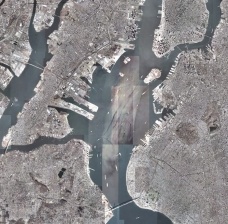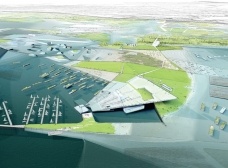
newspaper
agenda cultural
Rising Currents: Projects for New York’s Waterfront, a major initiative organized by The Museum of Modern Art and P.S.1 Contemporary Art Center to propose solutions for the effects of climate change on New York‘s waterfronts, culminates in an exhibition at The Museum of Modern Art from March 24 through October 11, 2010. The exhibition presents architectural proposals that emphasize adaptive ?soft? infrastructure solutions for New York and New Jersey‘s Upper Bay to make New York City and surrounding areas more resilient in responding to rising sea levels and more frequent storm surges. Elements of the proposals range from the creation of salt- and freshwater wetlands along the banks of the bay and a Venice-like aqueous landscape, to habitable piers and manmade islands, and a protective reef of living oysters. Five multidisciplinary teams of New York-based architects, engineers, and landscape designers selected to participate in Rising Currents developed the proposals during the initiative‘s workshop phase at P.S.1 Contemporary Art Center, from November 2009 to January 2010.
Rising Currents: Projects for New York’s Waterfront is organized by Barry Bergdoll, The Philip Johnson Chief Curator of Architecture and Design at MoMA. Guy Nordenson, professor of structural engineering and architecture at Princeton University and a faculty associate of the Princeton University Center for Human Values, served as a consultant. Klaus Biesenbach, Director, and Antoine Guerrero, Director of Operations and Exhibitions, at P.S.1 Contemporary Art Center, were instrumental in the organization of the workshop phase of Rising Currents, which was part of the P.S.1 initiative Free Space, an ongoing program in which artists and non-profit arts organizations are invited to use available gallery space for rehearsals, workshops, research, and events in exchange for an exhibition or live presentation for P.S.1 visitors.
"The innovative proposals developed during the intensive workshop at P.S.1 extend beyond even my most optimistic expectations" said Mr. Bergdoll. "Not only has Rising Currents created a set of visions for a different kind of harbor city, but it also is illustrative of a new role for P.S.1 and MoMA in stimulating and harnessing debate about vital issues of public concern in architecture and urban planning. Climate change is seen here not simply as a problem to be confronted, but an opportunity to be seized. As the city charts its future in coming decades with the realities of changed sea levels and more frequent storm surges, the proposed projects featured in this exhibition represent realistic possibilities whose impact and influence could be felt in the not-so-distant future. The projects are truly 'glocal' that is, conceived for local conditions, but with global implications".
The five teams of architects, engineers, and landscape designers—led by principals at Architecture Research Office (ARO) with dlandstudio, LTL Architects, Matthew Baird Architects, nARCHITECTS, and SCAPE/LANDSCAPE ARCHITECTURE PLLC—have conceived projects for five sites, identified and researched by the Latrobe Team (a multi-disciplinary Princeton University affiliated group funded by the Fellows of the American Institute of Architects and led by structural engineer Professor Guy Nordenson, and including his associates Catherine Seavitt and Adam Yarinsky). The Latrobe Team‘s study, and the related publication, On the Water: Palisade Bay, served as the framework for the teams‘ work toward adaptive and widely applicable infrastructure for the sites, which is on view in this exhibition.
To provide the context for understanding the problems and issues that the teams were required to address during the workshop phase of Rising Currents, the exhibition begins with a background presentation of the Latrobe Team‘s project, including its final master plan and schematic proposals, a detailed presentation of topographic and bathymetric data, as well as projected flooding based on incremental sea level rise. Nordenson, Seavitt, and Yarinsky's work is the basis for the various proposals for the coastline of New York and New Jersey, not only to render it both more resilient for climatic changes to come, but also to reorient the perception and the experience of the city around the water, allowing New York to join a host of cities around the world from Copenhagen and Amsterdam to Singapore and Hong Kong, which increasingly focus on an active waterfront of mixed use.
At the center of the exhibition are the physical and digital models and drawings produced by the five teams, whose members worked collaboratively to create the exhibition with members of MoMA‘s Department of Exhibition Design and Production.
Rising Currents inaugurates a new series of Architecture and Design exhibitions at MoMA called Issues in Contemporary Architecture, which will focus on timely topics in contemporary architecture with an emphasis on the urban dimension in order to increase public dialogue around seminal issues.

Aerial view of Palisade Bay
Credit: Palisade Bay Team: Guy Nordenson and Associates, Catherine Seavitt Studio, Archite

Concert Pier
LTL Architects

